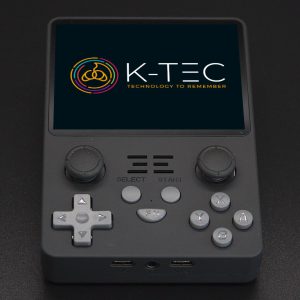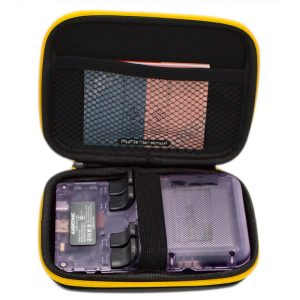-
 PowKiddy RGB20S retro handheldPrice range: £69.90 through £84.90
PowKiddy RGB20S retro handheldPrice range: £69.90 through £84.90 -
 Hardshell case for Anbernic RG353V or PowKiddy RGB20S£12.90
Hardshell case for Anbernic RG353V or PowKiddy RGB20S£12.90
Tuning
We have used our expert knowledge to tune the configuration of your PowKiddy handheld. If you discover other tips or configurations that enhance your experience, please use the contact form to let us know. Here’s a list of the changes we’ve made.
microSD cards
The microSD cards that PowKiddy usually supplies with its handhelds are unbranded and we are not satisfied with their reliability. Therefore, we ship these devices with brand-name microSD cards.
We are so confident about the quality of these cards that we provide a lifetime guarantee.
It’s important to make a backup
Even with the lifetime guarantee we give our microSD cards, it is still recommended that you backup your card(s) as soon as you receive your device. See How to backup your retro handheld’s microSD card(s)
Firmware
We have replaced the stock firmware with the ArkOS custom firmware. In our testing, ArkOS provided excellent balance between ease of use and performance. We have further refined the configuration of the firmware with settings specific to the RGB20S.
N64
Use the Standalone-Rice emulator
Standalone-Rice performs better on this device than the default Parallel-N64 retroarch core.
To try a different emulator, see Hints -> Trying different cores/emulators in this guide.
Configure the button-mapping for use with Standalone-Rice
Without configuration, this emulator uses an incomplete and uncomfortable mapping for the inputs. We have configured the inputs to match the common layout used for N64 emulation (L1 used for L-targeting, right analogue-stick directions used for C-inputs).
PSP
Our configuration is tuned for individual games. The configuration files are stored in psp/ppsspp/PSP/SYSTEM/ on the EASYROMS partition of the SD card. Our configurations are based on those found at https://github.com/jserodio/rg351p-ppsspp-settings/.
PSP pushes the limit of what this kind of device can emulate, but these settings give you the best available experience.
You can show the menu used to alter these settings by pressing L2.
GameBoy
Set the screen colour to a light green, matching the original GameBoy display
If you would like to try a different colour palette, bring up the Retroarch Quick Menu while in-game (SELECT + X), then going to Options -> Internal Palette.
Save the changes by going back up a menu level (press B) until you see the Overrides item; then select Overrides -> Save Current Directory Overrides.
Dreamcast
We have set the core used for emulation to RETRORUN32 -> Flycast32_Rumble.
To try a different emulator, see Hints -> Trying different cores/emulators in this guide.
All Retroarch cores
Shaders
We have configured shaders to improve the display of retro games on your RGB20S’s high-resolution screen.
Set the aspect ratio to Core Provided
This tells Retroarch’s cores to conform to the shape of each device’s original screen shape, preventing games from appearing squashed.
Ports
Ports are games that have been ported to run natively on your device.
Hints
Hotkeys
Note
L3 is the button function (click it) of the left-hand analogue stick; R3 is the same for the right-hand stick.
| Action | Hotkey |
| Safe power-off | R3 + power button |
| Quit game | SELECT + START twice (once for some stand-alone emulators) |
| Sleep | Power button quick press; press again to wake up |
| Add favourite | Y when in game list |
| Remove favourite | Y when in favourites list |
| Retroarch quick menu | SELECT + X |
| Retroarch quick save | SELECT + R1 |
| Retroarch quick load | SELECT + L1 |
| Retroarch fast forward | SELECT + R2 (hold) |
| Retroarch rewind | SELECT + L2 (can undo a small fail) |
Turning off the device
Hotkey
Press R3 (the right-hand analogue stick) and the POWER button together.
Using the menu
Press START, then go down to Quit, and choose Shutdown System.
Hard shutdown or reset
If the device crashes and neither of the previous two methods work, you can perform a hard shutdown by holding the POWER button. Similarly, you can press the RESET button to perform a hard reset.
You should use these only as a last resort, as they risk data corruption.
Note
Your PowKiddy device is a handheld computer and, as such, should be powered down in a safe manner. Otherwise, there is a risk of data corruption.
Quitting a game
When using a retroarch core
Most systems are emulated using Retroarch cores.
You can press SELECT + START on the device, twice in quick succession, to quit a game.
Standalone emulators and Ports
Some systems use stand-alone emulators. These include N64, PSP, Dreamcast, and Nintendo DS. Pressing SELECT + START once will quit most of these. Most Ports are quit using the same method.
Nintendo DS: The Nintendo DS emulator (Drastic) is quit by using its menu. You can display the menu by pressing L3. The text is tiny but the last menu option is the one you use to quit.
Sleep
You can put your PowKiddy handheld into sleep mode with a short-press of the POWER button. If you press the power button again, the device will quickly return to the state it was in before entering sleep mode.
This mode drains the battery at a very slow rate. However, we don’t recommend leaving your device in sleep mode for days at a time. It will eventually run out of battery and the unsafe shutdown may result in data corruption.
Show the battery level
When in the system selection or game list screens, press the START button. The battery level, along with other status information, is shown in the second-to-last entry.
Show the Retroarch menu
Select RETROARCH from the main menu and then either retroarch or retroarch32. These are 64-bit and 32-bit versions of the software, respectively. The available game systems are configured to use the 32-bit or 64-bit depending on which happens to work best for that system.
To bring up the Quick Menu, press SELECT + X while in-game.
Updating the firmware
Make sure to backup your microSD card before performing an update. This requires an internet connection. Attach a compatible USB adapter and WiFi dongle. Connect to your WiFi router by using the Options -> WiFi menu entry (use the shoulder buttons to change focus between items on the screen).
To perform an update, use the Options -> Update menu entry and follow the instructions. You may need to use the shoulder buttons to navigate between items on the screen.
Important
Updating the installed firmware may provide improved performance or stability. However, it should also be noted that it’s possible an update could overwrite some of the refinements we’ve made the device’s configuration.
Screen-saver
After several minutes of sitting idle, your handheld will start playing videos of random installed games. This is the screen-saver. To play the game currently displayed, press START. To exit the screen-saver, press one of the face buttons.
Trying different cores/emulators
To try a different emulator for a specific game, press SELECT on the game list screen, then choose Edit this game’s metadata -> Emulator.
Nintendo DS
Nintendo DS uses the stand-alone emulator, Drastic.
Games that do not use touch-screen input are the most usable.
L2 swaps between the two screens. Display the Drastic emulator’s menu by pressing L3 (the left-hand analogue stick). You quit DS games, and the Drastic emulator, using this menu. The menu text is tiny but the last entry is the one you use to quit.
Amstrad
When required, you can use the R1 button to bring up an on-screen keyboard.
Glossary
- ArkOS
- This is the Operating System that runs on your PowKiddy retro handheld device. It’s a version of Linux that’s been streamlined to run emulators most efficiently.
- Retroarch
- Retroarch provides most of the cores/emulators that run games. The Retroarch menu is used to configure its cores.
- Core
- A Core is an emulator that has been adapted to work with Retroarch.
- Emulator
- Using an emulator, your device pretends that it’s a different device. For instance, using the PPSSPP emulator, your PowKiddy retro handheld pretends that it’s a PlayStation Portable. It can then run games designed for the PSP. Some devices are more difficult to emulate than others, such as the Nintendo 64 or Sega Dreamcast.